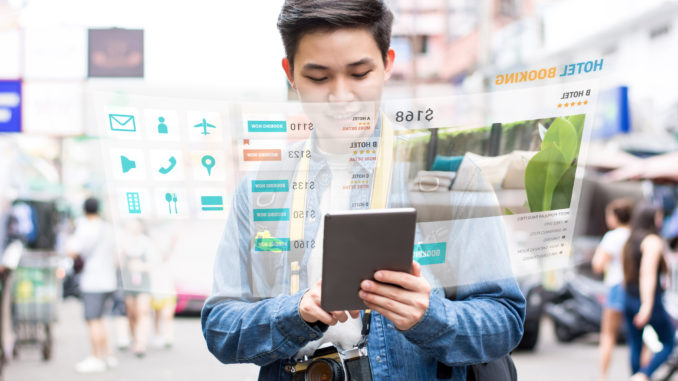
By Noel Connolly, SVP Global Head of Sales Air & Hospitality at CellPoint Mobile
Now that mobile technology is defining what’s expected from hotels, many operators I’ve talked to find themselves in a good position to move new mobile strategies forward, but they need to justify their technology investments with higher conversions, lower operational costs and more revenue overall.
The key will be using digital channels for promotions and content that can both harness and enhance the guest experience while driving revenues. Mobile is the most direct and relevant device to support this sort of 360-degree, omni-channel guest experience, and hotels will need a mobile-first strategy to match.
With basic mobile infrastructure in place (payments, promotions), hotels can tie together different revenue strategies and link specific mobile tactics (real-time offers, geo-fencing, keyless entry) to a larger strategy for revenue, loyalty and customer acquisition.
Revenue and Customer Growth with Digital Payments and Fulfilment
The mentality of a hotel guest today has been shaped by travel technology and ecommerce more generally. Guests have little time or patience for sifting through a booking engine and rely heavily on UX features to search, sort and sift for them. They need rich content that provides relevant information and makes “comparison shopping” faster and easier. And they appreciate value-added promotions for both rates and amenities.
To support these opportunities, more hotels are upgrading their booking engines, websites and apps with a better user experience. But elevating the guest experience requires more than just an optimized sales channel. Hotels need to connect the selling side to the payment and promotions side of guest experience. Payments and promotions are less about the hotel’s own digital properties and more about their ability to connect their selling channel to guests’ mobile devices, which are constantly evolving.
Many hotels now offer native mobile apps with support for alternative payment methods (APMs) like Apple Pay or Google Pay and other features that offer more of a 360-degree guest experience (keyless entry, voice-activated devices). By enhancing their payment experience, hoteliers are less tied to traditional transaction processes like room charge folios or card-swipe terminals, as any location can be a mobile point of sale. Hotels can offer lower rates online knowing that they can make up the revenue during the guest stay, with targeted promotions and ancillary offers for events, services, activities and more.
Rather than just promote an event during the booking process, when they are less likely to see uptake, hotels can deliver real-time mobile promotions once the customer checks-in and is more likely to be interested. Hotels are using geo-fencing to deliver mobile promotions exactly when the guest is near the event location or another targeted area (restaurant, bar). Many hotel apps now support keyless entry and other useful features which give guests a reason to use the app throughout their stay and engage with the hotel’s other content, promotions and offers in the mobile channel. And with promotion management software on the back-end, hotels are able to easily orchestrate their mobile campaigns and tie them into larger sales and revenue strategies.
The Mobile Payment Experience for Hotel Guests
While some hotels have made significant investments in their mobile booking engines (MBEs), many lack a plan for when bookers want to use an alternative payment method (APM) like Apple Pay, Google Pay or Alipay – are these APMs supported by the hotel’s technology infrastructure? If not, that’s probably a missed booking, maybe a deleted hotel app, and certainly a wasted strategic investment.
Many hoteliers have at least attempted to capture more revenue with a mobile app, but without a seamless and frictionless path to purchase it makes it harder for hotels to drive revenue from mobile offers – like offering discounted tickets to an event as guests walk by. Payments have a major impact on hotels’ mobile success because content and promotions are only useful insofar as they feature a seamless path to purchase – think of how easy it is to pay for an Uber.
Currently, more than a third (39%) of hotel bookings are made on mobile devices, a figure that jumps to 80% for last-minute travel bookings. The online travel agencies (OTAs) that originate most of these bookings understand how users interact with their websites and apps and what kind of content and UX travelers expect. But OTAs also partner with payment service providers (PSPs) to keep up with new mobile wallets that often determine where travelers book (they will go where their mobile wallet is accepted). The payment experience is really the most basic element of the entire guest and customer experience – nothing happens without payment.
Part of creating a 360-degree brand experience is ensuring guests can use their devices as they normally would. Payments are a part of everyday life (think of micropayments like in-app purchases), and hotel guests shouldn’t have to think about them – the process should be embedded into the mobile experience. Promotions should lead seamlessly to a purchase whether the customer is responding to a text message or push promotion via hotel app. And with support for mobile payments, hotels can more easily “unbundle” the guest experience and treat any moment or touchpoint (check-in, pool time) as an opportunity for engagement, up-selling and cross-selling.
Mobile Solutions for Hotel Challenges and Opportunities
When it comes to moving forward with strategies for the mobile channel – i.e., meeting guests’ booking and payment needs and managing promotions on the back end – often the first hurdle for hoteliers is thinking more proactively about using mobile to cut costs and grow revenue. It’s not always about finding a “magic bullet,” but taking incremental steps to be more mobile-friendly. Not every hotel challenge or opportunity has a straightforward solution, but the mobile channel is designed to be flexible, scalable and interoperable with other systems, solutions and travel sectors. And that’s what makes it such a worthwhile investment.
The hotels we’ve talked with who are embracing more proactive mobile strategies have been able to increase conversions by accepting new mobile wallets and optimizing their mobile promotions to be more relevant and timely. They are able to enhance the guest experience and the customer experience while increasing revenues through the mobile channel. This is what a mobile-first hotel sector looks like, and more hoteliers are adopting these approaches with better capabilities for payments and promotions.
 Noel Connolly is CellPoint Mobile‘s Senior Vice President of Global Sales, Air & Hospitality, based in the company’s Dubai office.
Noel Connolly is CellPoint Mobile‘s Senior Vice President of Global Sales, Air & Hospitality, based in the company’s Dubai office.
Are you an industry thought leader with a point of view on hotel technology that you would like to share with our readers? If so, we invite you to review our editorial guidelines and submit your article for publishing consideration.
